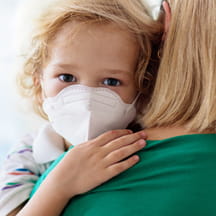Since the beginning of the pandemic, Rosemary Olivero has closely monitored COVID-19 infections at Helen DeVos Children's Hospital in Grand Rapids, Michigan. Lately, she's seeing some troubling trends emerge:
- For the month of April 2021, the hospital saw more than 2,200 COVID-19-infected children—nearly 20% higher than the previous high in November 2020.
- The 10- to 20-year-old age group produced the highest positivity rate among all age groups tested for COVID-19 in the community during April.
The COVID-19 hospitalization rate at Helen DeVos Children's Hospital has remained steady since the fall, but the numbers don't tell the entire story. Patients often tested positive for COVID-19 after being admitted to the hospital for unrelated conditions.
But now, Olivero and her team are seeing more children coming to the hospital specifically to treat symptoms of the virus.
"In April, we saw a far higher proportion of hospitalizations with acute respiratory COVID-19, some of whom were extremely ill," says Olivero, M.D., pediatric infectious disease specialist, Helen DeVos Children's Hospital. "That's very different from any other time at our facility during the pandemic—it really raised our level of concern."
4 factors key to spiking pediatric infections
Olivero says these trends mirror what her colleagues across Michigan are seeing and are in line with a surge in pediatric COVID-19 cases around the country. According to a report from the Children's Hospital Association and the American Academy of Pediatrics, COVID-19 infections among children for the week ending April 29 accounted for 1 in 5 newly reported virus infections.
According to Olivero, there are several reasons behind the widespread increase in COVID-19 infections among children and adolescents:
- Variants. New strains of the virus are often more contagious than previous variants—the highly contagious United Kingdom (UK) B.1.1.7 variant is a driving force behind Michigan's recent surge.
- Susceptible population. Children under 16 weren't eligible to receive the COVID-19 vaccine and, as a group, have little immunity to the virus.
- School and sports. Olivero says schools and organized sports have generally done a good job adhering to best practices for COVID-19 mitigation but says gatherings of children outside those structured environments—such as after-school or postgame get-togethers—are promoting the spread of the virus.
- Behavioral aspects. Olivero cites pandemic fatigue as a factor in transmission, observing more complacency recently with mask wearing and social gatherings without proper distancing.
"When you have a more contagious virus and fewer people wearing masks in an unvaccinated population, it's really a breeding ground for this virus," Olivero says.
Preventing infections as a community
Key to stemming the tide of pediatric COVID-19 infections, according to Olivero, is continued adherence to the "tried and true" mitigation efforts—masks, social distancing, proper handwashing hygiene and gathering outdoors as much as possible.
However, she says widespread vaccine adoption among adults is the best tool to protect the country's youngest populations from COVID-19. With vaccine eligibility expanding to anyone 12 years and older, she says the primary focus for health care providers should be on public education and vaccine advocacy.
"We're trying to motivate people to take some ownership of the pandemic mitigation efforts," Olivero says. "If we could achieve a higher level of immunity among our high schoolers through vaccinations before the beginning of the fall semester, it would be absolutely massive toward getting through this pandemic."



